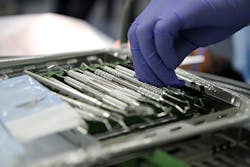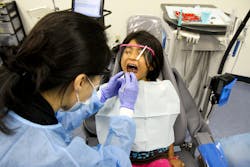Survey highlights patients’ attitudes toward dentistry and concerns about infection control
The survey found that parents in the general population take their children to the dentist for the first time at the average age of two and a half, while parents who fall under the U.S. poverty threshold take their children to the dentist for the first time at approximately three and a half years old.
The survey, released today, assesses patients’ attitudes, knowledge, and beliefs about dental care for themselves and their children. The paper, titled “Survey Analysis of Parental Awareness and Behaviors Regarding Children’s Dental Care and Dental Infection Control,” is available for download at www.SupportCleanDentistry.com.
“The lack of knowledge parents have and the lack of urgency of taking their children to the dentist by age one is very concerning to me,” said Timothy S. Martinez, DMD, College of Dental Medicine associate dean of Community Partnerships and Access to Care, and the lead author of the survey report. “Age one is a perfect time to get a child into the dental office and begin preventative dental care that will minimize decay and early childhood caries.”
The survey was conducted in the U.S. among 304 adults, ages 18 to 65, in the general population and 75 adults, ages 18 to 65, who fell below the poverty threshold.
Among the survey’s respondents with children under the age of 18, a majority of parents are not taking their children to the dentist before age one, even though 60% of the parents are aware of the AAPD’s recommendation. Across all socioeconomic groups, a majority of parents are not complying simply because they “didn’t think it was necessary.” The second most common reason was that their child’s pediatrician or doctor said it wasn’t necessary. The reasons diverge among low-income respondents, with 22% worrying that they can’t afford dental care or that insurance won’t cover it. Although compliance for 1-year-old dental visits was very low, 88% of parents took advice from their dental professional and had sealants applied when recommended.
“The top three actions that parents can take to be advocates for children’s good oral health are to take them to a dental home or dental visit by age one, make sure that their child gets sealants on their teeth, and send their child to a dental office that has a safe and clean environment,” Dr. Martinez said.
The survey also found that recent dental infection control breaches covered in the news media have influenced patient attitudes about cleanliness at the dentist. Of the people who recalled seeing or hearing these news stories (107 people), more than half of them said they have changed their outlook on going to the dentist:- 41% report they are now more attentive to the cleanliness in the dental office.
- 21% also claimed to be more nervous about visiting the dentist.
- 14% say they now ask their dental professionals more questions about how they clean the dental equipment and office.
- 46% report that the news stories did not change their outlook.
For the most part, patients are confident that their dental practitioners are doing everything they can to create a clean environment and provide sterile equipment.
“The last thing the dental profession wants is for people to perceive infection control practices as a barrier to visiting a dentist,” Martinez said. “Disposable dental supplies such as bib holders, eye protection, and air-water syringe tips are available, and patients can request these products if they are concerned about infection control practices in a dental office. Using disposable supplies prevents the transfer of germs from previous patients or dental professionals.”
High-resolution video and photos are available for download at www.SupportCleanDentistry.com/Media.








